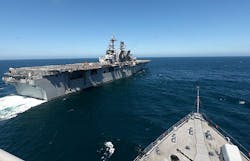The U.S. Navy’s Naval Surface Warfare Center Dahlgren Division (NSWCDD) recently institutionalized its Technical Excellence Framework to achieve enhanced levels of quality, security, and safety in the U.S. fleet. Joe Heil, NSWCDD deputy chief engineer explains that the move is driven by John Fiore, the organization’s technical director.
“Mr. Fiore is championing the implementation of a Technical Excellence Framework (TEF) which is composed of a set of project execution requirements, training, internal project reviews, technical excellence metrics, and data-driven continuous improvement that apply to all NSWCDD projects,” says Heil. “Mr. Fiore’s commitment to technical excellence is demonstrated by his active participation in monthly department technical execution reviews, his technical excellence related blogs to thousands of Dahlgren scientists and engineers, and his open-door meetings once a week where any employee can drop by and talk.”
Prior to Fiore’s arrival as NSWCDD technical director, the NSWCDD Chief Engineers (CHENG) Council defined and initiated implementation of the Technical Excellence Framework for mission-critical naval warfare. As effectively as the council operated, it was without a unified vision, which Fiore provided.
The Naval Surface Warfare Center Dahlgren Division (NSWCDD) has institutionalized a Technical Excellence Framework for improved naval quality, security, and safety. (Courtesy of U.S. Navy)
“Mr. Fiore took the lead while validating the best practices we were trying to make happen and he is doing that through departmental technical execution reviews and his blogs,” says Heil. “He is personally championing technical rigor, discipline and excellence.”
Heil details the visions, goals, and best practices of the NSWCDD Technical Excellence Framework in a white paper available from the Navy Office of Community Outreach. “The lives of the warfighters depend on our products and systems,” remarks Heil. “We must therefore execute all projects with fundamental data-driven best-practice-based, technical rigor, discipline, and excellence.”
About the Author
Jack Browne
Technical Contributor
Jack Browne, Technical Contributor, has worked in technical publishing for over 30 years. He managed the content and production of three technical journals while at the American Institute of Physics, including Medical Physics and the Journal of Vacuum Science & Technology. He has been a Publisher and Editor for Penton Media, started the firm’s Wireless Symposium & Exhibition trade show in 1993, and currently serves as Technical Contributor for that company's Microwaves & RF magazine. Browne, who holds a BS in Mathematics from City College of New York and BA degrees in English and Philosophy from Fordham University, is a member of the IEEE.


